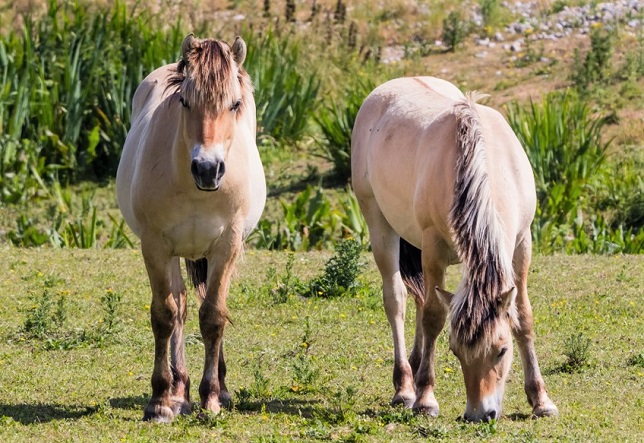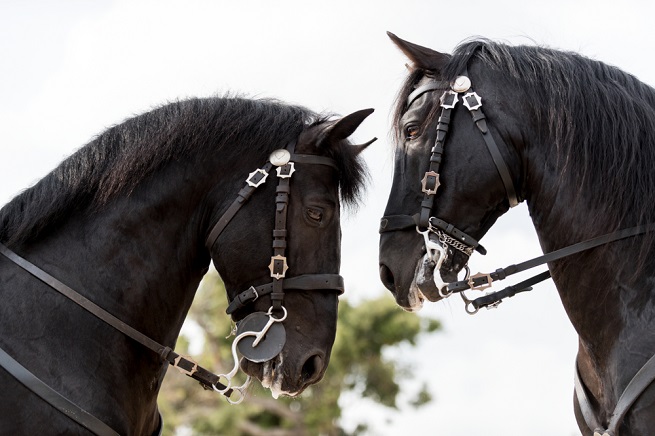Horses have been our loyal companions for over 6,000 years. During that time, more than 600 horse breeds developed, either naturally or via selection by humans.
Sadly, many horse breeds remain unknown outside their native country or region. In turn, breeds that excel in equestrian sports or are popular in the Western world get more media attention.
Everybody’s heard of the speedy Thoroughbred, the graceful Arabian, or the athletic Dutch Warmblood. But have you heard of the rugged Hequ Horse or the raven black Mallorqín?
In this article, we pay tribute to the horses few people talk about by exploring some of the most obscure breeds on the planet!
Here are ten horse breeds you’ve never heard of:
1. Aegidienberger

The Aegidienberger is a small gaited horse breed from the district of the same name in western Germany. It is essentially a cross between the Peruvian Paso and the Icelandic horse that became its own breed in 1994.
The purpose of this combination was to create a gaited horse that is taller than the Icelandic and still able to navigate rough terrain.
Besides having an unpronounceable name, the Aegidienberger also has unique gaits like the tölt. The average height of Aegidienberger horses is 13 to 15 hands, and breed registries accept all colors.
Unfortunately, the Aegidienberger never really gained popularity in the equestrian world. Breed numbers haven’t exceeded 100 since the launch of the studbook and have been declining over the years.
2. Giara Horse

imageBROKER.com / Shutterstock.com
The Giara Horse is an Italian horse breed native to the island of Sardinia. In Italian, its name means “plateau horse” which refers to the rocky basaltic plateau these horses call home.
The origins of the Giara Horse are obscure. It’s possible the ancestors of the breed came to the island with the Phoenicians or the Greeks around 500-400 BC. Giara Horses have been a part of local culture for centuries, and there are still free herds roaming the plateau to this day.
While breed numbers are currently stable and count around 700 horses, this wasn’t always the case. Due to the mechanization of the 20th century, the Giara Horse drifted to the brink of extinction. In 1971, the Sardinian horse breeding institution founded a breeding center to save the horses.
Despite its small size, the breed is considered a horse as its body proportions resemble horses more than ponies. The Giara Horse can range from 11.1 to 13.1 hands in height, and its most common colors are bay, black, and chestnut.
3. Balikun Horse

The Balikun Horse is a versatile horse breed from the Xinjiang autonomous territory in northwest China. These horses have been selectively bred for over 200 years, and likely descend from native Mongolian and Kazakh horses.
Balikun Horses are commonly used for riding, packing, and light draft work. A Balikun Horse can reportedly carry loads weighing 220 pounds (100 kg) for up to 50 miles (80.5 km) a day.
Locals still use Balikun horses for transportation as the infrastructure connecting the region’s vast distances is largely undeveloped.
Due to its harsh natural habitat, the Balikun Horse is exceptionally resilient and tough. The horses grow thick coats in the winter that keep them warm even if temperatures drop below zero.
The Balikun Horse is on average 14 to 15 tall and usually have a bay or chestnut colored coat. Its appearance is slightly more athletic compared to its distant cousin, the Mongolian Horse.
Also, read our guide to the 15 native Chinese horse breeds.
4. Henson Horse

Philippe PATERNOLLI / Shutterstock.com
The Henson Horse is a relatively new horse breed from northeast France. Its history dates back less than 50 years to the end of the 1970s, when the region’s demands for horse riding holidays increased. This prompted breeders to create a leisure horse breed suitable for equestrian tourism.
The Henson Horse emerged from crosses of French saddle horses and the Norwegian Fjord Horse. A breed society was formed in 1983 to oversee the development of the new breed, and the studbook closed in 1995. The Henson Horse has been an official breed in France since 2003.
Since the breed has 25% to 50% Fjord blood, it closely resembles its Norwegian ancestors. However, the Henson Horse is slightly taller and lighter, standing at 14.3 to 15.3 hands. The breed is frequently dun with primitive markings, but bay is also acceptable.
Henson Horses have good endurance and will do well both under saddle and in harness. They are also hardy horses and several breeders allow their herds to graze freely in the wetlands of France during the winter.
5. Mallorquín
 Santiago Salinas / Shutterstock.com
Santiago Salinas / Shutterstock.com
The Mallorqín is a rare Spanish horse breed native to the island of Mallorca, from which it takes its name. Its exact origins are unknown, although genetic studies found links with the Catalan, an extinct horse breed.
Similar to the Henson Horse, the Mallorqín has only been an official breed since 2003. A studbook was previously established in 1988, and four years later, a breed society was founded. Today, the Mallorqín is a popular riding horse among the local community.
The Mallorquín has a typical baroque outline, but it’s more slender than other Iberian breeds. The only acceptable color is jet black, with minimal white markings permitted on the head. The average height of a Mallorquín horse is between 14.2 and 15 hands.
In 2000 and 2007, the Food and Agriculture Organization of the United Nations listed the Mallorquí breed as “critical-maintained.” This means that an institution or breeding program is keeping breed numbers stable, preventing the Mallorquín from extinction.
In 2010, the total population consisted of 146 horses, which rose to 320 by 2018. (Source: Wikipedia.
6. Kaimanawa Horse

Lyntree / Shutterstock.com
The Kaimanawa Horse is a collective name for all feral horses in New Zealand. They descend from domestic horses that escaped into the wilderness in the 19th and 20th centuries.
Horses first set foot in New Zealand in 1814, and within a few decades, several wild herds formed from the loose horses roaming the Kaimanawa Range. Every now and again, locals recaptured some of these animals and trained them to be riding horses.
As the 20th century progressed, human expansion left less and less space for wild horses to roam freely. By 1979, the number of Kaimanawa Horses dropped to only 174.
The New Zealand government declared the breed a part of national heritage, and by 1994, the number of horses rose to 1,576.
Due to their mixed origins, Kaimanawa Horses vary greatly in appearance. They can be anywhere between 12.2 and 15 hands tall and occur in every color. These horses are also very versatile and often become the mounts of showjumpers and Pony Club riders in New Zealand.
To protect the horses’ habitat, the government rounds up the wild herd each year for population control. Animals of high genetic value are released to improve the existing population, and the rest are offered for rehoming.
7. Hequ Horse

Included in our list of Chinese horse breeds, the Hequ Horse lives on the northwestern Tibetan plateau. Its origins trace back to Tang Dynasty period of Chinese history (618-907 AD). Among the ancestors of the Hequ Horse were the Ferghana, the Tibetan Pony, and the Mongolian Horse.
The breed is famous for living in hypoxic environments at altitudes of 10,000 to 16,000 feet (3000 to 5000 m).
The Hequ Horse has also adapted well to the extreme winter temperatures of the region. Its metabolism enables the breed to gain weight quickly during the summer and accumulate fat reserves for the winter.
The Hequ has remarkable endurance and is often used by locals for riding and light draft work. Once a populous horse breed, Hequ Horse numbers have declined due to the mechanization of transport in China.
The breed encompasses three subtypes with distinct body conformation: the Suoke, the Jiaokea, and the Kesheng. Hequ Hoses on average measure 12.3 to 14.3 hands and are commonly gray, black, or bay.
8. Noma Horse

OLYMPUS DIGITAL CAMERA
The Noma Horse or Noma-uma is a rare Japanese horse breed from the island of Shikoku. Out of the eight native Japanese horses, the Noma Horse is by far the smallest.
Horses first arrived on the Japanese islands around the sixth century AD. In the beginning, these animals worked in agriculture and transported goods.
In the middle ages, larger horses were required for warfare, and the small horses like the Noma continued working as pack animals. These horses are considered the ancestors of the Noma Horse.
Sadly, the Noma Horse population in Japan was decimated by the wars and mechanization of the 20th century. By 1978, only six horses remained, out of which two were in a zoo and four at a private breeder.
Thanks to the foundation of the Noma Uma Highland reserve, breed numbers rose to 84 by 2008.
Included in the smallest horse breeds, the Noma Horse is no bigger than a Shetland Pony, although it’s hardy and agile on mountainous terrain. The breed is mainly a tourist attraction today, but some places also use it for riding or equine therapy purposes.
9. Vyatka Horse

Ashur_Ro / Shutterstock.com
The Vyatka Horse is an endangered horse breed named after the Vyatka River of Russia. This Russian horse breed descends from native Estonian horses that came to northern Russia with Novgorod colonists in the 14th century.
The unforgiving climate and terrain of the region shaped the Vyatka horse into a hardy and agile breed with good endurance. In the 19th century, the Vyatka Horse was famous for pulling troikas, a traditional Russian carriage drawn by three horses.
The breed nearly went extinct in the early 20th century but came back to life after the Russian Revolution (1917-1923). In 2003, the population consisted of 560 horses. As of 2007, the Vyatka Horse is on the Food and Agriculture Organization’s Endangered List.
The Vyatka is a versatile ride and drive horse that was originally dun with primitive markings. Today, the Vyatka Horse is usually bay, chestnut, black, or roan in color. The Vyatka Horse is relatively small, standing around 13.5 hands at the withers.
10. Zaniskari

Joe Ravi / Shutterstock.com
The Zaniskari is a rare pony breed from the mountainous region of Ladakh in northern India. Like the Hequ Horse, it has adapted to living in a high-altitude environment and can endure temperatures as low as -40 °C (-40 °F).
The Zaniskari likely diverged from Tibetan horse breeds at some point in history. Once common in northern India, breed numbers have declined to only a few hundred due to extensive crossbreeding.
The Indian government started a conservation program to save the breed from extinction, and numbers are now stable.
Zaniskari ponies are often gray but can also be black, chestnut, or bay. The average height of a Zaniskari horse is 11.3 to 13.3 hands. In India, the Zaniskari are popular riding and polo ponies noted for their sure-footedness and good endurance.
Source: horseyhooves.com








